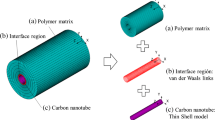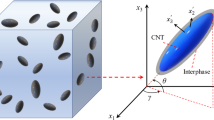Abstract
A method for the numerical modelling of mechanical behaviour of nanocomposite materials reinforced with the carbon nanotubes, based on computational homogenization as a multi-scale method, is presented. Since the carbon nanotube inside of the representative volume element (RVE) is modelled as a space frame structure, theoretical background and a proper way of modelling of carbon nanotubes is given. Novelty in this paper is an incorporation of interactions, based on the weak van der Waals forces and modelled by nonlinear rod elements, into a multiscale model as described below. An algorithm is developed for analysis of those interactions. Since the problem of modelling nanocomposite structures is a three-dimensional multi-scale problem, one part of this work is dedicated to multi-scale modelling methods, especially to the first order computational homogenization. Computational homogenization and representative volume element are the basis of the presented numerical model of the nanocomposites. Nano scale model is based on beam and non-linear rod finite elements. For the purpose of the software verification, examples, i.e. models of the nanocomposite material are presented. Obtained results are compared with the results given by the other authors.





Similar content being viewed by others
References
Iijima S (1991) Helical microtubules of graphitic carbon. Nature 354:56–58
Treacy MMJ, Ebbesen TW, Gibson TM (1996) Exceptionally high Young’s modulus observed for individual carbon nanotubes. Nature 381:680–687
Wong EW, Sheehan PE, Lieber CM (1997) Nanobeam mechanics: elasticity, strength, and toughness of nanorods and nanotubes. Science 26:1971–1975
Yu M, Lourie O, Dyer MJ, Moloni K, Kelly TF, Ruoff RS (2000) Strength and breaking of multiwalled carbon nanotubes under tensile load. Science 28:637–640
Xie S, Li W, Pan Z, Chang B, Sun L (2000) Mechanical and physical properties on carbon nanotube. J Phys Chem Solids 61:1153–1158
Lu JP (1997) Elastic properties of carbon nanotubes and nanoropes. Phys Rev Lett 79:1297–1300
Yakobson BI, Campbell MP, Brabec CJ, Bernholc J (1997) High strain rate fracture and C-chain unraveling in carbon nanotubes. Comput Mater Sci 8:341–348
Bernholc J, Brabec C, Buongiorno Nardelli M, Maiti A, Roland C, Yakobson BI (1998) Theory of growth and mechanical properties of nanotubes. Appl Phys A 67:39–46
Overney G, Zhong W, Tomanek D (1993) Structural rigidity and low frequency vibrational modes of long carbon tubules. Z Phys D 27:93–96
Iijima S, Brabec C, Maiti A, Bernholc J (1996) Structural flexibility of carbon nanotubes. J Chem Phys 104:2089–2092
Ruoff RS, Qian D, Liu WK (2003) Mechanical properties of carbon nanotubes: theoretical predictions and experimental measurements. Physique 4:993–1008
Chang T, Gao H (2003) Size-dependent elastic properties of a single-walled carbon nanotube via a molecular mechanics model. J Mech Phys Solids 51:1059–1074
Liew KM, Wong CH, Tan MJ (2006) Tensile and compressive properties of carbon nanotube bundles. Acta Mater 54:225–231
Zhang Y, Huang H (2008) Stability of single-wall silicon carbide nanotubes—molecular dynamics simulation. Comput Mater Sci 43:664–669
Wise K, Hinkley J (2001) Molecular dynamics simulations of nanotube-polymer composites. In: American Physical Society spring meeting, pp 12–16
Govindjee S, Sackman JL (1999) On the use of continuum mechanics to estimate the properties of nanotubes. Solid State Commun 110:227–230
Brcic M, Canadija M, Brnic J (2007) Structural model of single walled carbon nanotube. Bulletins for Applied and Computer Mathematics 2304:67–74
Brcic M, Canadija M, Brnic J, Lanc D, Krscanski S, Vukelic G (2009) FE modelling of multi-walled carbon nanotubes. Eston J Eng 15:78–86
Canadija M, Brcic M, Brnic J (2013) A finite element model for thermal dilatation of carbon nanotubes. Rev Adv Mater Sci 33:1–6
Curtin WA, Miller RE (2003) Atomistic/continuum coupling in computational materials science. Modelling and Simulation in Materials Science and Engineering 11:33–68
Ansari R, Mirnezhad M, Sahmani S (2012) An accurate molecular mechanics model for computation of size-dependent elastic properties of armchair and zigzag single-walled carbon nanotubes. Meccanica. doi:10.1007/s11012-012-9671-x
Odegard GM, Gates TS, Wise KE, Park C, Siochi EJ (2003) Constitutive modeling of nanotube-reinforced polymer composite. Compos Sci Technol 63:1671–1687
Odegard GM, Gates TS, Nicholson LM, Wise KE (2002) Equivalent-continuum modeling of nano-structured materials. Compos Sci Technol 62:1869–1880
Wan H, Delale F (2010) A structural mechanics approach for predicting the mechanical properties of carbon nanotubes. Meccanica 45:43–51
Tan H, Jiang LY, Huang Y, Liu B, Hwang KC (2007) The effect of van der Waals-based interface cohesive law on carbon nanotube-reinforced composite materials. Compos Sci Technol 67:2941–2946
Lau K (2003) Interfacial bonding characteristics of nanotube polymer. Chem Phys Lett 370:399–405
Zeng QH, Yu AB, Lu GQ (2008) Multiscale modeling and simulation of polymer nanocomposites. Prog Polym Sci 33:191–269
Namilae S, Chandra N (2005) Multiscale model to study the effect of interfaces in carbon nanotube-based composites. J Eng Mater Technol 127:222–232
Tserpes KI, Papanikos P, Labeas G, Pantelakis SG (2008) Multi-scale modeling of tensile behaviour of carbon nanotube reinforced composites. Theor Appl Fract Mech 49:51–60
Li C, Chou TW (2006) Multiscale modeling of compressive behaviour of carbon nanotube/polymer composites. Compos Sci Technol 66:2409–2414
Figiel L, Dunne FPE, Buckley CP (2009) Multiscale modelling of layered-silicate/pet nanocomposites during solid-state processing. In: IUTAM symposium on modelling nanomaterials and nanosystems, vol 13, pp 19–26
Kouznetsova VG, Geers MGD, Brekelmans WAM (2004) Multi-scale second-order computational homogenization of multi-phase materials: a nested finite element solution strategy. Comput Methods Appl Mech Eng 193:5525–5550
Geers MGD, Kouznetsova VG, Brekelmans WAM (2010) Multi-scale computational homogenization: trends and challenges. J Comput Appl Mech 234:2175–2182
Omidi M, Alaie S, Rousta A (2012) Analysis of the vibrational behavior of the composite cylinders reinforced with non-uniform distributed carbon nanotubes using micro-mechanical approach. Meccanica 47:817–833
Babaei H, Shahidi AR (2012) Free vibration analysis of quadrilateral nanoplates based on nonlocal continuum models using the Galerkin method: the effects of small scale. Meccanica. doi:10.1007/s11012-012-9646-y
Chen XL, Liu YJ (2004) Square representative volume elements for evaluating the effective material properties of carbon nanotube-based composites. Comput Mater Sci 29:1–11
Liu YJ, Chen XL (2003) Evaluations of the effective material properties of carbon nanotube-based composites using a nanoscale representative volume element. Mech Mater 35:69–81
Shokrieh MM, Rafiee R (2010) On the tensile behavior of an embedded carbon nanotube in polymer matrix with non-bonded interphase region. Compos Struct 92:647–652
Li C, Chou TW (2003) A structural mechanics approach for the analysis of carbon nanotubes. Int J Solids Struct 40:2487–2499
Li C, Chou TW (2004) Modeling of elastic buckling of carbon nanotubes by molecular structural mechanics approach. Mech Mater 36:1047–1055
Li C, Chou TW (2003) Elastic moduli of multi-walled carbon nanotubes and the effect of van der Waals forces. Compos Sci Technol 63:1517–1524
Kalamkarov AL, Georgiades AV, Rokkam SK, Veedu VP, Ghasemi-Nejhad MN (2006) Analytical and numerical techniques to predict carbon nanotubes properties. Int J Solids Struct 43:6832–6854
Jorio A, Dresselhaus MS, Saito R, Dresselhaus G (2011) Raman spectroscopy in graphene related systems. Wiley-VCH, Berlin
Lennard-Jones JE (1924) On the determination of molecular fields. I. From the variation of the viscosity of a gas with temperature. Proc R Soc Lond 106:441–462
Battezzati L, Pisani C, Ricca F (1975) Equilibrium conformation and surface motion of hydrocarbon molecules physisorbed on graphite. J Chem Soc 71:1629–1639
Sawczuck A, Bianchi G (1985) Plasticity today: modelling, methods and applications. Elsevier, Amsterdam
Bathe KJ (1996) Finite element procedures. Prentice-Hall, New Jersey
Geers MGD, Kouznetsova VG (2010) Scale transitions in solid mechanics based on computational homogenization. In: 17th CISM-IUTAM summer school: modelling and simulation of multiscale continuum systems, Udine
Hill R (1963) Elastic properties of reinforced solids: some theoretical principles. J Mech Phys Solids 11:357–372
Dresselhaus MS, Dresselhaus G, Saito R (1995) Physics of carbon nanotubes. Carbon 33:883–891
Jones RM (1999) Mechanics of composite materials, 2nd edn. Taylor & Francis, Philadelphia
Pantano A, Cappello F (2008) Numerical model for composite material with polymer matrix reinforced by carbon nanotubes. Meccanica 43:263–270
Acknowledgements
The research presented in this paper was realized within the scientific project No. 069-0691736-1737 “Numerical analysis of structural response for specific service conditions” financially supported by the Ministry of Science, Education and Sport of the Republic of Croatia.
Author information
Authors and Affiliations
Corresponding author
Rights and permissions
About this article
Cite this article
Brcic, M., Canadija, M. & Brnic, J. Estimation of material properties of nanocomposite structures. Meccanica 48, 2209–2220 (2013). https://doi.org/10.1007/s11012-013-9738-3
Received:
Accepted:
Published:
Issue Date:
DOI: https://doi.org/10.1007/s11012-013-9738-3




